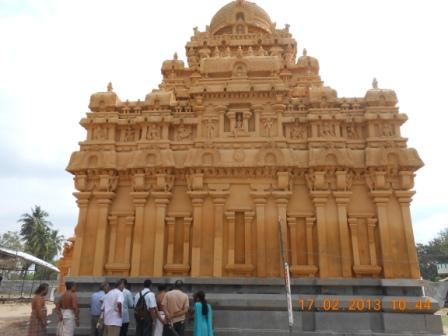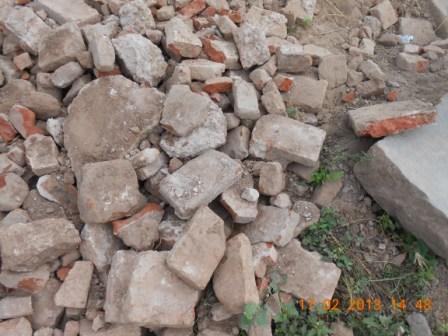17,
February 2013
Received a
mail from Mr. Chandra, PRO of Reach Foundation for the tour to
Uthiramerur and Gudalur Shiva temples on 17-02-2013, SUNDAY. Since it was a
holiday, I readily accepted and confirmed the same. He reminded me on Saturday
evening also over my mobile. It was cloudy when I started from my
home. After leaving my two-wheeler at SPIC Office, reached Guindy HP Petrol
Bunk near the Railway station for the van to board. It was raining till we
got into the van. We left Guindy around 07-30 Hrs against the scheduled time
of 6.45 Hrs.
Even though this was my second trip to Uthiramerur
Sri Kailasanathar Temple, I had been there on 13-03-2011 with my
wife, at that time temple was not constructed fully and Kumbhabhishekam
was also not performed. This time I was fortunate enough to Join with the
eminent personalities from Archaeology, Epigraphy, and History. Learned a lot from
all these people.
KAILASANATHAR
TEMPLE, UTHIRAMERUR.
Moolavar : Sri Kailasanathar.
Consort : Sri Kamakshi
Amman.
Some of the important details of this temple are...
The temple faces east.
Balipeedam and Rishabam are in front. The sanctum sanctorum is about 4 feet above
the ground level and steps are provided on the east side. Moolavar is a little
big. A passage called Santharam/ circumambulatory path is provided around the
sanctum. In the prakaram Vinayagar. A Stucco image of SomasKandar was
constructed behind Moolavar which is unique to this temple.
ARCHITECTURE
The Temple consists of sanctum sanctorum, antarala, and ardha mandapam. The
superstructure above the Adhistanam is built with brick. The adhistanam is of simple pada bandha adhistanam. The Bhitti or the wall is provided with koshtas /
niches. The prastaram is with Kabotham. Bhuta ganas are in the valapi. The
haram is also with 6 parts. As per an article Published by
Emma Natalya Stein
andKatherine E. Kasdorf
, the bhitti niches are with Yogini Images South side view
HISTORY AND INSCRIPTIONS
The temple was built during Pallava King Nandi Varman’s
period and reconstructed during the Chozha period with stone up to Adhistanam.
Later patronized by Chozha Kings Parataka Chozha_I, Rajaraja-I, Rajendra
Chozha-I, and Vijayanagara Kings, especially Krishnadevaraya. As per Chozha period inscriptions this place was called Uttirameru Chaturvedimangalam and Shiva was called Kailayamudiya Mahadevar. The inscriptions mainly record donations made to this
temple in terms of Land, Gold, Goats, Cows, etc for the regular poojas and
functions. In one of the inscriptions it was mentioned that if the body obstructs
the normal functioning of the temple poojas and lighting of lamps received
through gifts ( By way of gold, Land, cows ) to the temple, it will be equivalent
to killing their father and mother and Killing a cow on the banks of river Ganga. (This much of pavam/Sin will be added to them).
Rajendra Chozha-I's period ( 1015-1016 CE ) inscription records the endowment of Naivedyam of rice, ghee, vegetables, and beetle nut for three services and burning of sandhi lamp, for the same land was gifted to the temple
There is a measurement scale marked at the base of the temple
in two lengths each 11 feet with Vijayanagara Kings Royal emblem of Kattari
and Sun.
The Kumbhabhishekam was performed in 2013 after renovation.
Technical assistance was extended by the Reach Foundation for the reconstruction of this temple back to its glory.
Our team members studying the inscriptions - Back side view of the temple
Mr Ramachandran Sir is explaining the inscriptions
The Scale of measurement ends with Vijayanagar Kings' royal symbols - Kattari and SUN
TEMPLE TIMINGS:
The temple will be kept open between 06.00 hrs to 12.00 hrs and 16.00 hrs to
21.00 hrs.
HOW TO REACH
About
a KM from the Bus stand.
Uthiramerur is 27 KM from Kanchipuram, 31 Km from Chengalpattu, and 90 KM from
Chennai.
Buses are available from Chennai, Kanchipuram, and Chengalpattu.
Nearest Railway Junction is Chengalpattu.
LOCATION OF THE TEMPLE: CLICK HERE
Front view of the Kailasanathar Temple
Pillayar Sannadhi
North side view with Chandikeswarar sannidhi
Front arch construction is in progress
The broken pieces of a pot were collected from the site. As per the archaeologist, the pieces must be 1000 years old.
Sri Agneechurar Temple, Gudalur.
After
Pooja at Sri Kailasanathar Temple continued our journey
to GUDALUR. On the we have lost around an hour due to burst of
van’s back tire. After replacing the tire reached Sri AAGNEECURAR, Shiva
temple ( The name appeared from the Tamil inscriptions found
under the base ), which was in a dilapidated condition. The
meaning of Aagneechurar is the son of AGNI AAGNI, who worshiped Lord Shiva
of this temple ). Since the temple is facing west, Lord Shiva’s name must be
Abhimukeswarar, assumed by the persons in charge of the reconstructions, which
was wrong.
Tamil
inscriptions are found in base and pillar stones. The temple is about three
feet below the ground level. Moolavar is visible only up to the top of avudayar.
Moolavar is in a slanting posture. From the image of Chandikeswarar the
temple was constructed during the 10th century during
Pallava’s period. The name of the village is the same as the one in the
inscriptions. The temple was constructed first with bricks and later it was
re-constructed with stone. To prove this the excavated bricks are square and
rectangular with thin shapes. One of the inscriptions says there exists a
Rajendra Chozha’s Cheppu Thirumeni in the temple.
We have
excavated outside the base and found Gomukha and a collection pot for
the abhisheka tirtha made of stone without any damage / intact. There is a
chance of getting Ambal’s image and other parivara images, if we excavate
further. It was around 15.30 hrs, and team members got exhausted and very hungry.
Returned to Chennai after having an evening lunch at Hotel Highway Inn with sweet memories.
Chandikeswarar with Mazhu in hand
Rishabam
Temple site with mandapam pillars
Tamil inscriptions on one of the slabs
Mr Ramachandran Sir is taking a copy of the inscription on the pillar
Excavated bricks
Gomukha and collection pot for Abhisheka tirtha
The images recovered so far
Please
visit the following site to get more about these temples and the activities of REACH FOUNDATION.
























































